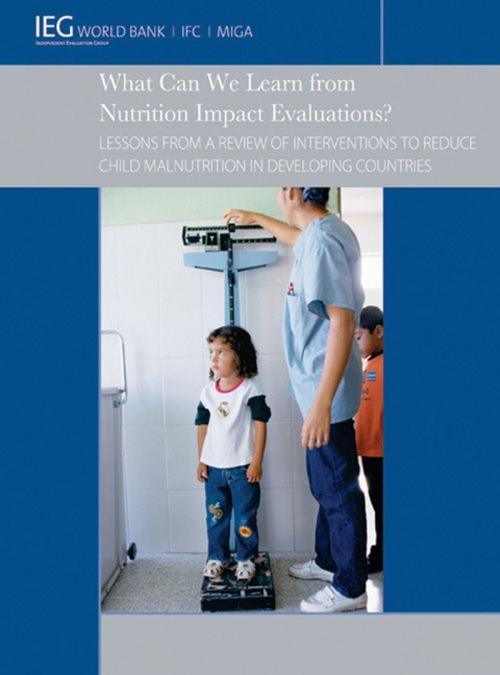What Can We Learn From Nutrition Impact Evaluations?: Lessons From A Review Of Interventions To Reduce Child Malnutrition In Developing Countries
Nonfiction, Health & Well Being, Medical, Patient Care, Nutrition| Author: | Ainsworth Martha | ISBN: | 9780821384077 |
| Publisher: | World Bank | Publication: | August 27, 2010 |
| Imprint: | Language: | English |
| Author: | Ainsworth Martha |
| ISBN: | 9780821384077 |
| Publisher: | World Bank |
| Publication: | August 27, 2010 |
| Imprint: | |
| Language: | English |
High levels of child malnutrition in developing countries contribute to mortality and have long-term consequences for children's cognitive development and earnings as adults. Recent impact evaluations show that many different interventions have had an impact on children's anthropometric outcomes (height, weight, and birth weight), but there is no simple answer to the question "What works?" to address the problem. Similar interventions have widely different results in different settings, owing to differences in local context, the causes and severity of malnutrition, and the capacity for program implementation.Impact evaluations of programs supported by the Bank, which are generally large-scale, complex inter-ventions in low-capacity settings, show equally variable results. The findings confirm that it should not be assumed that an intervention found effective in a randomized medical setting will have the same effects when implemented under field conditions. There are many robust experimental and quasi-experimental methods for assessing impact under difficult circumstances often found in field settings.The relevance and impact of nutrition impact evaluations could be enhanced by collecting data on service delivery, demand-side behavioral outcomes, and implementation processes to better understand the causal chain and what part of the chain is weak, in parallel with impact evaluations. It is also important to understand better the distribution of impacts, particularly among the poor, and to document better the costs and effectiveness of interventions.High levels of child malnutrition in developing countries are contributing to mortality and present long-term consequences for the survivors. An estimated 178 million children under age 5 in developing countries are stunted (low height for age) and 55 million are wasted (low weight for height). Malnutrition makes children more susceptible to illness and strongly affects child mortality. Beyond the mortality risk in the short run, the developmental delays caused by undernutrition affect children's cognitive outcomes and productive potential as adults. Micronutrient deficiencies vitamin A, iron, zinc, iodine, for example are also common and have significant consequences. Progress in reducing malnutrition has been slow: More than half of countries are not on track to achieve the Millennium Development Goal of halving the share of children who are malnou-rished (low weight for age) by 2015. The food price and financial crises are making achievement of this goal even more elusive.
High levels of child malnutrition in developing countries contribute to mortality and have long-term consequences for children's cognitive development and earnings as adults. Recent impact evaluations show that many different interventions have had an impact on children's anthropometric outcomes (height, weight, and birth weight), but there is no simple answer to the question "What works?" to address the problem. Similar interventions have widely different results in different settings, owing to differences in local context, the causes and severity of malnutrition, and the capacity for program implementation.Impact evaluations of programs supported by the Bank, which are generally large-scale, complex inter-ventions in low-capacity settings, show equally variable results. The findings confirm that it should not be assumed that an intervention found effective in a randomized medical setting will have the same effects when implemented under field conditions. There are many robust experimental and quasi-experimental methods for assessing impact under difficult circumstances often found in field settings.The relevance and impact of nutrition impact evaluations could be enhanced by collecting data on service delivery, demand-side behavioral outcomes, and implementation processes to better understand the causal chain and what part of the chain is weak, in parallel with impact evaluations. It is also important to understand better the distribution of impacts, particularly among the poor, and to document better the costs and effectiveness of interventions.High levels of child malnutrition in developing countries are contributing to mortality and present long-term consequences for the survivors. An estimated 178 million children under age 5 in developing countries are stunted (low height for age) and 55 million are wasted (low weight for height). Malnutrition makes children more susceptible to illness and strongly affects child mortality. Beyond the mortality risk in the short run, the developmental delays caused by undernutrition affect children's cognitive outcomes and productive potential as adults. Micronutrient deficiencies vitamin A, iron, zinc, iodine, for example are also common and have significant consequences. Progress in reducing malnutrition has been slow: More than half of countries are not on track to achieve the Millennium Development Goal of halving the share of children who are malnou-rished (low weight for age) by 2015. The food price and financial crises are making achievement of this goal even more elusive.















